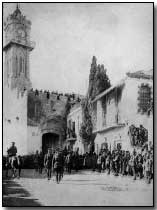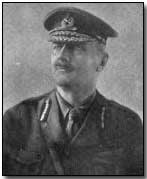Battles - The Fall of Jerusalem, 1917
 Barely pausing for consolidation following the
Battle of Mughar
Ridge on 13 November 1917, British Commander-in-Chief
Sir
Edmund Allenby marched eastwards towards Jerusalem via the Judea Hills.
Barely pausing for consolidation following the
Battle of Mughar
Ridge on 13 November 1917, British Commander-in-Chief
Sir
Edmund Allenby marched eastwards towards Jerusalem via the Judea Hills.
While his right headed for the Judea Hills his left force adopted a defensive posture at Jaffa, newly secured by the British. Allenby was nevertheless aware of the arrival of General Erich von Falkenhayn's Yilderim Force, markedly strengthening the Turkish lines from Jerusalem to the sea.
Falkenhayn lost little time in launching attacks from his Seventh Army, succeeding in greatly slowing Allenby's advance. It soon became apparent that Allenby would be unable to secure Jerusalem's fall without first consolidating his force. Both commanders had been specifically instructed of the necessity to avoid fighting either in or immediately around the holy city itself.
Having reinforced his front line force Allenby assigned the task of capturing Jerusalem to XX Corps under fellow cavalry officer Sir Philip Chetwode. Chetwode's attack consequently began on 8 December. The assault took two forms: a central thrust from Nebi-Samweil - a commanding series of heights some 13km to the west; and a secondary attack south at Bethlehem.
In the event the city fell after a single day's fighting, with morale in the Turkish opposition having plummeted in the face of continual British successes combined with the failure of Turkish counterattacks. Sporadic fighting nevertheless continued in the surrounding hills in the days following Jerusalem's fall.
 Demonstrating a fine
political sensibility Allenby chose to make his understated entrance into the holy city
on foot on 11 December. (Click
here to view the city's decree of surrender.)
Demonstrating a fine
political sensibility Allenby chose to make his understated entrance into the holy city
on foot on 11 December. (Click
here to view the city's decree of surrender.)
Falkenhayn mounted a determined counter-attack on 26 December which was thrown back with heavy Turkish losses. Allenby's overall campaign had incurred casualties of some 18,000 men set against 25,000 Turkish losses.
The loss of Jerusalem constituted a grave setback to Ottoman prestige in the region and rendered nought the effective potential of Falkenhayn's Yilderim Force.
With Allenby having secured the British line from Jerusalem to the sea he had delivered upon British Prime Minister David Lloyd-George's instruction to take Jerusalem by Christmas with weeks to spare. News of its capture provided much welcome relief in Allied capitals in Europe, offsetting less satisfying news from Russia, Caporetto and Cambrai.
In the wake of Allenby's success the War Office in London postponed operations in Mesopotamia in preparation for a renewed offensive in Palestine.
Click here to read Allenby's account of the fall of Jerusalem. Click here to read the official Austro-German report on events which led to the fall of the city. Click here to read a historical overview of the city's fall, written by the secretary of the British Palestine Society, E W G Masterman. Click here to read Allenby's official proclamation of marshal law.
Click here to view a map detailing the fall of Jerusalem and other actions during 1917.
Photographs courtesy of Photos of the Great War website
A 'whizzbang' was a high-velocity, low-trajectory shell that made a shrill approach noise and then a sharp explosive report.
- Did you know?
